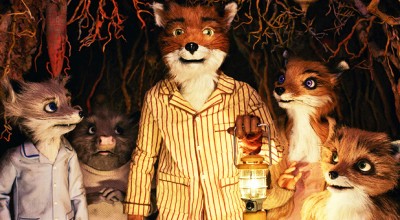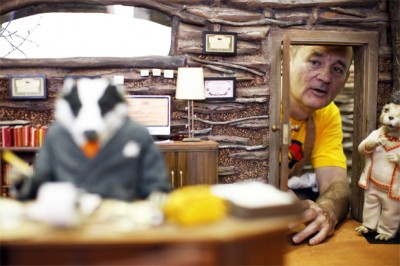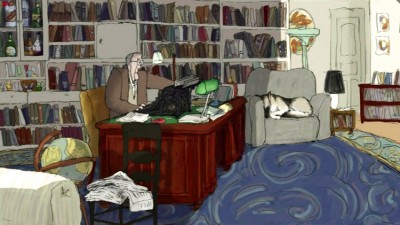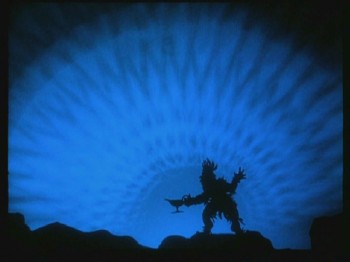Commentary 18 Nov 2009 08:57 am
3 Animated Features
- Three animated features in the past four days. That’s a lot – at least compared to what I see theatrically in the rest of the year. Only one was in the running for the Oscar, this year; all three were brilliant in their own ways. All three were directed by forceful directors with something on their minds.
 - That one running for the Oscar was The Fantastic Mr. Fox. This is the work of a live-action director, Wes Anderson, who has built a personality for himself on film. All of his feature work has been eccentric, all have featured a cast of regulars; none of his films have been blockbuster success stories. But they’ve all done well and have their built-in-audience.
- That one running for the Oscar was The Fantastic Mr. Fox. This is the work of a live-action director, Wes Anderson, who has built a personality for himself on film. All of his feature work has been eccentric, all have featured a cast of regulars; none of his films have been blockbuster success stories. But they’ve all done well and have their built-in-audience.
With The Fantastic Mr. Fox, Anderson has built a studio in England staffing it with a supervising director from the staff of the Will Vinton Studio. Mark Gustafson had more than a little control over the making of The P.J.s and animated on Vinton’s Mark Twain feature. The animation for Mr. Fox wasn’t gloriously slick in the way Coraline or Up was; it looked as though someone’s fingerprints were all over the sets and dolls and frames of this film. That was part of the charm.
The rest of the secret of this film comes wholly out of Anderson’s way of working and directing. He was a country away from the set, yet he was able to communicate easily via the Internet and was able to review everything in production. He trusted Gustafson and gave him space to lead the crew – the way any good director would do.
 I remember one day at the Hubley studio on a break. Crossing Park Avenue on my way to a store, I thought about how happy I was in this job. I thought about the work I was doing. Then, smack, I’d come to realize that I was drawing Hubley drawings. My artwork wasn’t as good, but it looked like a Hubley drawing – not a Sporn drawing. What I was doing had little to do with me and all to do with John Hubley. I don’t know how he got me to do that; I don’t know how he got all of us to do that – John was so hands off. Yet, there it was: a Hubley film! That was when I realized how a director had to work to get the most from the artists and creators involved in the film. I haven’t forgotten my lesson.
I remember one day at the Hubley studio on a break. Crossing Park Avenue on my way to a store, I thought about how happy I was in this job. I thought about the work I was doing. Then, smack, I’d come to realize that I was drawing Hubley drawings. My artwork wasn’t as good, but it looked like a Hubley drawing – not a Sporn drawing. What I was doing had little to do with me and all to do with John Hubley. I don’t know how he got me to do that; I don’t know how he got all of us to do that – John was so hands off. Yet, there it was: a Hubley film! That was when I realized how a director had to work to get the most from the artists and creators involved in the film. I haven’t forgotten my lesson.
It’s obvious that Wes Anderson knows what he’s doing. Every inch of his film is fun and charming and delightful. Every frame of it is adult, yet kids can enjoy it as well (and they certainly did at the screening I attended.) [Richard O'Connor has a great review of this film. I suggest you read it.]
- A second feature I’d seen was another eccentrically odd puppy of a film. My Dog Tulip was completely drawn, animated and colored by Paul and Sandra Fierlinger. Paul wrote the script from a British best seller by J.R. Ackerly.
 The film told the story of a relationship between a man and his dog; it was a close bond between the two – a curmudgeon of a man and his overprotective dog. Within a short time, the film grew peculiar because it focussed on Ackerly’s concern for the urine, feces, other bodily effluvia of the dog, including its sexual needs. Having not read the book, actually, I’m not sure if these were so prominent in the original or if this was something Paul attended to in writing the screenplay. I assume the words were all Ackerly’s. They are the heart of the film, so Paul obviously wanted it this way, and it makes it somewhat off-putting to any general audience.
The film told the story of a relationship between a man and his dog; it was a close bond between the two – a curmudgeon of a man and his overprotective dog. Within a short time, the film grew peculiar because it focussed on Ackerly’s concern for the urine, feces, other bodily effluvia of the dog, including its sexual needs. Having not read the book, actually, I’m not sure if these were so prominent in the original or if this was something Paul attended to in writing the screenplay. I assume the words were all Ackerly’s. They are the heart of the film, so Paul obviously wanted it this way, and it makes it somewhat off-putting to any general audience.
The film has had a hard time finding a distributor. I hope it does find a release. Much of the artwork is extraordinary. Paul animated completely within the computer using the TV Paint program. His wife, Sandra colored it all and painted the backgrounds, also in TV Paint. They used a sort-of watercolor technique with a color palette that felt as if it glowed, yet in reality was limited to soft grays and browns with spots of high color. It was very controlled in the digital copy I saw projected at the Film Forum. This is Karen Cooper‘s gem of a theater that is willing to trust and support artists in film.
The animated movement in the film was quite loose. It felt like a mix of James Stevenson and William Steig animated. I suspect that the completely digital drawing with TV Paint, as opposed to drawing on paper and scanning, has loosened Paul’s lines even more than it once did. There’s certainly been a gradual change in his work over the past few years. Different – not better or worse.
The celebrity actors include Christopher Plummer, Isabella Rosselini and Lynn Redgrave.
The film has received mixed reviews – that bodily fluid thing – and hopefully this will not hold it back in any way other than a small bump. So much work by these two artists went into this film; one wants the struggle to deservedly pay off.
- The third and final feature seen this weekend was screened at the Museum of Modern Art on Sunday evening. Lotte Reiniger‘s The Adventures of Prince Achmed was the first animated feature, done in 1926. Made just steps from the Bauhaus, in the throes of German Expressionism, this film in some way set the way for all features to follow. A very strong director with pure impulses created a long film – the first. Done in her style of back-lit 2D silhouette puppets, the film blazed techniques that were truly innovative.
The film was done, of course, in B&W, yet the print screened was digitally colored, predominantly in pastels. The music was supplied by pianist, Ben Model. He did well by the film, but I suppose my feelings toward this movie were shaped by my initial viewing years ago – back in the 70′s.
 It was a screening at the Galerie St. Etienne. They had set up a room that was long and narrow, two sets of folding chairs down each side with a 16mm projector in the rear. The projection was perfect, the film was colored optically (there was no digital anything back then), and the sound was a small orchestral accompaniment. This was a spanking new print.
It was a screening at the Galerie St. Etienne. They had set up a room that was long and narrow, two sets of folding chairs down each side with a 16mm projector in the rear. The projection was perfect, the film was colored optically (there was no digital anything back then), and the sound was a small orchestral accompaniment. This was a spanking new print.
Lotte Reiniger was in the house, and after the well-received film, she proceeded to give us a demonstration of how it was made. A very large lightbox was constructed on a primary stairwell, and we all gathered around. She cut out and constructed a puppet in front of us. Then she placed it on the light box and showed how she moved it. She told stories (which I’ll save for another post) which kept us smiling.
At one point, she looked up to those around the table and she was overtaken with emotion. She ran around the table and tightly embraced a very short, elderly woman. The demonstration was over. It was Lotte Lenya, standing only a couple of feet away from me. The two hadn’t seen each other in all those years.
Now I was taken with emotion. What an evening; what a delight.
Seeing the film again brings back memories. It’s a wonderful film, but the real life adventure which played out in front of me, back then, colored the film forever – more than even the computer would be able to do.

on 18 Nov 2009 at 10:06 am 1.Michael said …
That’s a hell of a story. I’ll bet it definitely created some strong associations to that film. Hope she wasn’t wearing her killin’ shoes that night…
on 18 Nov 2009 at 10:40 am 2.Molasses said …
Lucky days to have so much good work to watch. Thanks for sharing your Lotte experience.
Hope it’s cool to correct you on this…
El Apóstol was the first animated feature, made in 1917. However it was claimed by fires. There’s a doc about it: http://www.quirinocristianimovie.com/
Prince Ahmed is the oldest surviving feature.
on 18 Nov 2009 at 3:22 pm 3.Niffiwan said …
Wasn’t the original release of “Achmed” also colored? I think scenes from the film were tinted (which could be done back then), and the digital coloring on the new release reproduces that. I remember reading that somewhere.
I’m looking forward to seeing “My Dog Tulip” very much. The scenes I saw on the website were hilarious and charming. I was planning to see it at the Waterloo Festival for Animated Cinema, but apparently its distributor has decided to prevent festivals from showing it in order to increase its chances of finding distribution. (how does this make sense?…)
on 18 Nov 2009 at 7:06 pm 4.Dennis Hermanson said …
Thanks for the wonderful intro to The Fantastic Mr. Fox. Of course, I love Wes Anderson movies. What amazes me ultimately, is, this must be one, if not the first, feature film to be made by a crew in England, a director in the USA, and none of the actors are real.
As you said,
“The rest of the secret of this film comes wholly out of Anderson’s way of working and directing. He was a country away from the set, yet he was able to communicate easily via the Internet and was able to review everything in production. He trusted Gustafson and gave him space to lead the crew – the way any good director would do.”
This is another indication of why the web, and this web site in particular, is a very strong part of your creative output, your creative energy, and the fact is, Michael, this web site you’ve created is more than yourself, yet because of you and all that you know and love that is called art and animation, is now a part of world culture.
Consider making all of it something that continues to exist after you do. It is in itself, a work of a lifetime, and many lifetimes.
In effect and in worldwide truth, this is a muse eum.
So, simply,
Thanks more than I can offer.
Now, back to work.
Dennis Hermanson
AKA Den NC USA
on 19 Nov 2009 at 5:30 am 5.slowtiger said …
“Prinz Achmed” was shot in bw, but always presented as a tinted copy, as most long silent films. The restauration the German Fim Museum (Deutsches Filmmuseum) did in 1998/99 mentions “Amber, Red, Blue, Green, Yellow, Straw” as colours used in the surviving nitro positive.